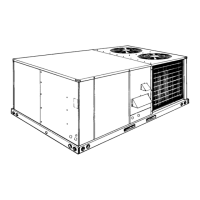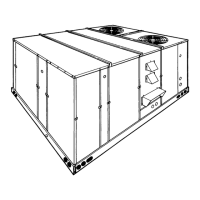362242-YIM-B-0109
Johnson Controls Unitary Products 37
PHASING
Check for proper compressor rotation. If the blower or
compressors rotate in the wrong direction at start-up,
the electrical connection to the unit is misphased.
Change the incoming line connection phasing to obtain
proper rotation. (Scroll compressors operate in only
one direction. If the scroll is drawing low amperage,
has similar suction and discharge pressures, or pro-
ducing a high noise level, the scroll is misphased).
SUPPLY AIR BLOWERS
These blowers have either multi-speed direct drive
motors, or single speed motors equipped with a belt
drive. Belt drive units have a variable pitch motor pulley
that allows the blower speed to be adjusted.
CHECKING SUPPLY AIR CFM
The RPM of the supply air blower will depend on the
required CFM, the unit accessories or options and the
static resistances of both the supply and the return air
duct systems. With this information, the motor speed
tap (direct drive) or the motor pulley number of turns
open (belt drive) can be determined from the Blower
Performance Data Tables.
Note the following:
1. The supply air CFM must be within the limitations
shown in the Unit Application Data Table 1.
2. Pulleys can be adjusted in half turn increments.
3. The tension on the belt should be adjusted as
shown in the Belt Adjustment Figure 12.
4. Tighten blower pulley and motor sheave set screws
after any adjustments. Re-check set screws after
10-12 hrs. run time is recommended.
Scroll compressors require proper rotation to
operate correctly. Do not change the internal
wiring to make the blower, condenser fans, or
compressor rotate correctly. Change the
incoming power to the main terminal block to
obtain proper rotation.
Belt drive blower systems MUST be adjusted to the
specific static and CFM requirements for the appli-
cation. The Belt drive blowers are NOT
set at the
factory for any specific static or CFM. Adjustments of
the blower speed and belt tension are REQUIRED
.
Tighten blower pulley and motor sheave set screws
after these adjustments. Re-checking set screws
after 10-12 hrs. run time is recommended.
FIGURE 12 - BELT ADJUSTMENT
Loosen nuts (A) (top and bottom).
Adjust the tension by turning bolt (B).
Never loosen nuts (C) from each other.
Use a belt tension checker to apply a perpendicular force to be one belt at the
midpoint of the span as shown. The deflection force should be applied
until a specific deflection distance of 4mm (5/32") is obtained. To determine
the deflection distance from normal position, use a straight edge from
sheave to sheave as a reference line. The recommended deflection force
is as follows:
1.
2.
3.
4.
PROCEDURE FOR ADJUSTING BELT TENSION:
Tension new belts at the max. deflection force recommended for the belt
section. Check the belt tension at least two times during the first 24 hours of
operation. Any re-tensioning should fall between the min. and max.
deflection force values.
5. After adjusting, re-tighten nuts (A).
*Never Loosen
(A)
(C)*
(B)
SPAN LENGTH
DEFL FORCE

